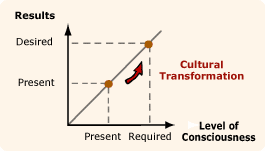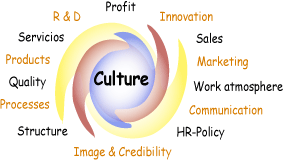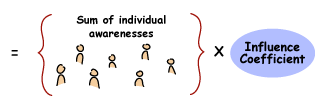- Examples of organisational cultures and how to recognise them (-> run mouse over the words)
Bureaucracy -
Empowerment -
Paternalism -
Innovation -
Competition
Basic principles
 - In the 21st century, an organisation's sustainability depends on its culture. Competitive advantages based on exclusive products, cost-efficiency or restricted know-how are disappearing. Corporate culture offers the competitive edge. - In the 21st century, an organisation's sustainability depends on its culture. Competitive advantages based on exclusive products, cost-efficiency or restricted know-how are disappearing. Corporate culture offers the competitive edge.
- Results and culture are related through a linear equation.
It means that any desired improvement in tangible results (quality, productivity, benefits...) requires a corresponding enhancement of the level of consciousness (=culture).
- Collective culture only evolves through individual awareness. Human beings are gregarious. In their effort to become integrated, people are subject to the influence of the community's belief system. The impact of this "influence coefficient" can be very powerful, in a positive or negative way.
- The size or history of an organisation increases the inherent sluggishness of its culture. The fact that organisations attract people who match their current culture and keep at bay those who differ only makes things worse! Both virtuous and vicious circles may arise: virtues endure but, equally, shortcomings persist.
- Culture has momentum. With sufficient maturity, an organisation keeps its identity regardless of the coming and going of its members.
- Organisational culture only evolves from within. Imported action plans, image campaigns, reengineering programs or even mergers fail to produce a new culture if they are not supported by a true evolution of collective consciousness.
Key points to develop corporate culture
1. The level of awareness of its leaders determines how far an organisation can go. In fact, its culture can’t evolve significantly without a personal growth process in its key figures.
2. The executive board’s and/or shareholders’ strong commitment to change is required to promote such far-reaching transformations.
3. The members of an organisation need to buy into the cultural transformation effort to be able to support it. The most effective way to legitimatise a change is to involve people in the process. Altoren is skilled at creating the appropriate setting for this involvement.
4. A group’s culture is its history. Recalling, respecting and honouring that history is the best way not to be trapped by it. Cultural transformation needs to integrate and take advantage of the past. And today’s shared experiences create the history and culture of tomorrow.
5. Drawing up a vision of the desired culture mobilises the available forces and puts a clearer focus on the next action steps.
6.It’s essential that mentalities and organisational processes are shifted simultaneously. Culture, with its inherent inertia and interconnection with every other aspect of the organisation, cannot be tackled in isolation. Changing operational processes without working on a behavioural shift is doomed to failure. The same happens when training and developing people is pursued without adjusting the organisation to the new mentality.
7. The main effort must be geared towards creating a critical mass of supporters of the culture change vision. This critical mass will then promote the new culture throughout the organisation (-> see Cascading Sponsorship model).
8.Integrity convinces: it’s important to communicate the desired culture and even more important to live up to it. Walk your talk. Good internal communication and an appropriate HR policy are the two pillars that confer coherence and consistency to the culture development project.

|








 - In the 21st century, an organisation's sustainability depends on its culture. Competitive advantages based on exclusive products, cost-efficiency or restricted know-how are disappearing. Corporate culture offers the competitive edge.
- In the 21st century, an organisation's sustainability depends on its culture. Competitive advantages based on exclusive products, cost-efficiency or restricted know-how are disappearing. Corporate culture offers the competitive edge.


